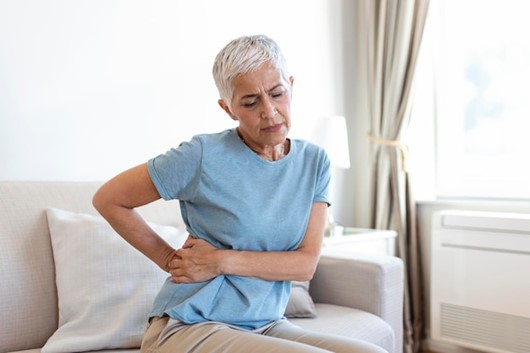This disease often affects the hip, wrist, and spine.
Bone is a living tissue continuously undergoing breakdown and renewal, but osteoporosis occurs when bone loss outpaces new bone creation.
Although it can impact anyone, white and Asian women, especially those post-menopause, are at the highest risk.
Effective management involves medications, a healthy diet, and weight-bearing exercises to prevent or address bone loss.
Symptoms and When to Seek Help
Osteoporosis often progresses without symptoms in its early stages.
Once bones are significantly weakened, signs may include:
- Back pain from a fractured spine.
- Gradual loss of height.
- A stooped posture.
- Frequent fractures from minor impacts.
Consult your doctor if you have early menopause, a history of long-term corticosteroid use, or a family history of hip fractures.
Early detection can help manage and mitigate the effects of osteoporosis.
Causes and Risk Factors
Osteoporosis occurs when there is an imbalance between the breakdown of bone tissue and the formation of new bone.
Several factors contribute to this condition:
- Age and Sex: Bone density decreases with age, and women, especially post-menopause, are at higher risk due to lower oestrogen levels.
- Race and Family History: Individuals of white or Asian descent and those with a family history of osteoporosis are more likely to develop the disease.
- Hormone Levels: Imbalances, such as decreased estrogen in women and testosterone in men or excessive thyroid hormone, can accelerate bone loss.
- Diet and Lifestyle: Insufficient calcium intake, eating disorders, gastrointestinal surgery, and certain medications can increase risk.
A sedentary lifestyle, excessive intake of alcohol, and smoking further exacerbate the likelihood of developing osteoporosis.
Complications of Osteoporosis
This condition can lead to complications, such as fractures, particularly in the hip and spine.
Hip fractures, often caused by falls, can result in significant disability and a higher risk of death within the first year of injury.
Spinal fractures may occur without a fall, causing back pain, reduced height, and a hunched posture.
These complications highlight the importance of managing osteoporosis effectively to maintain mobility and quality of life.
Prevention and Management
To maintain bone health and prevent osteoporosis:
- Calcium: Adults aged 18-50 need 1,000 mg daily, increasing to 1,200 mg for those over 50. Sources include low-fat dairy, dark green vegetables, and calcium-fortified foods.
- Vitamin D: Essential for calcium absorption; aim for 600 IU daily (800 IU for those over 70). Sources include sunlight, fortified foods, and supplements if necessary.
- Exercise: Engage in weight-bearing and strength-training exercises to build bone density and improve balance. Walking and jogging can significantly benefit bone health.
Stay proactive about your bone health! Consult your doctor to get a personalized plan for preventing or managing osteoporosis.





